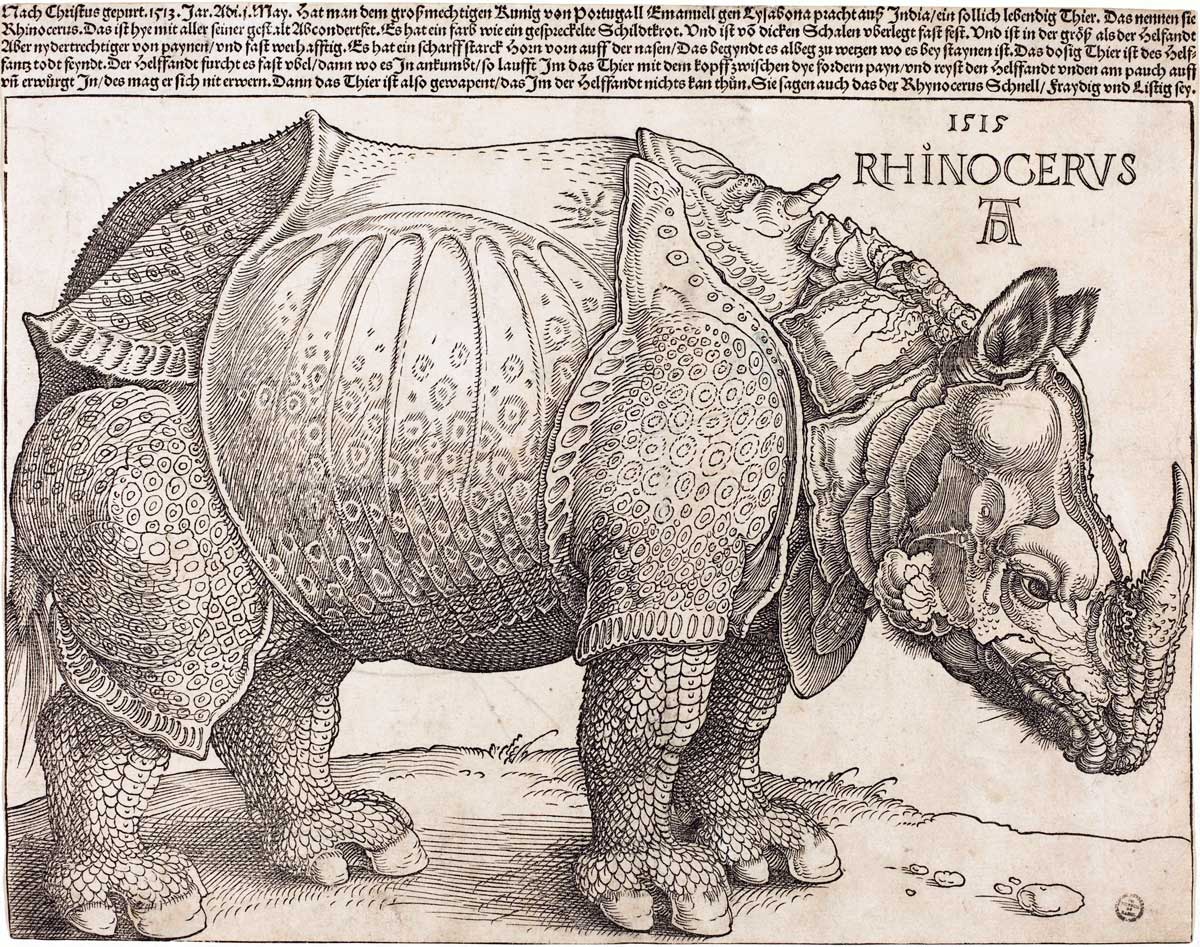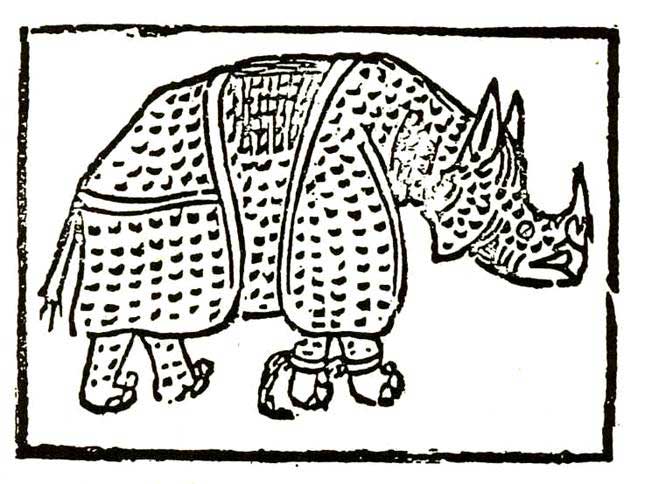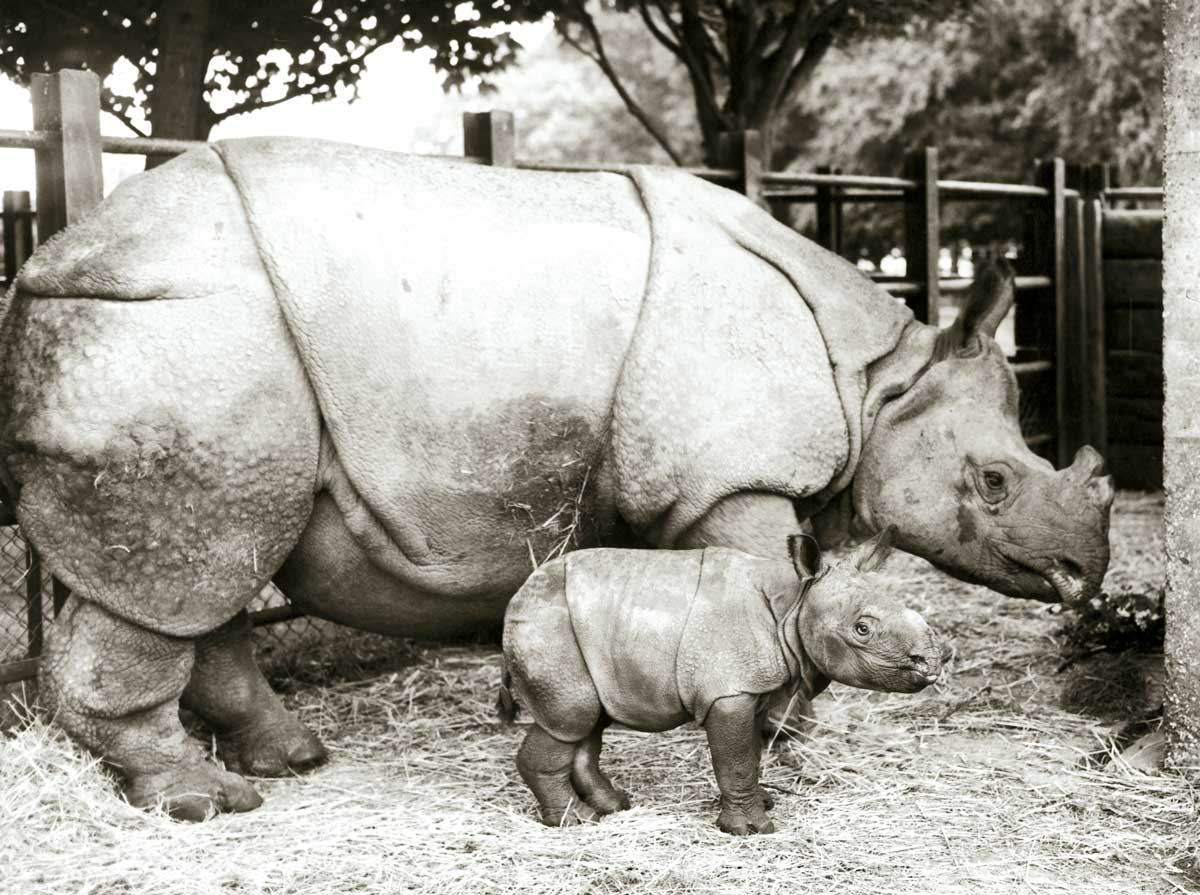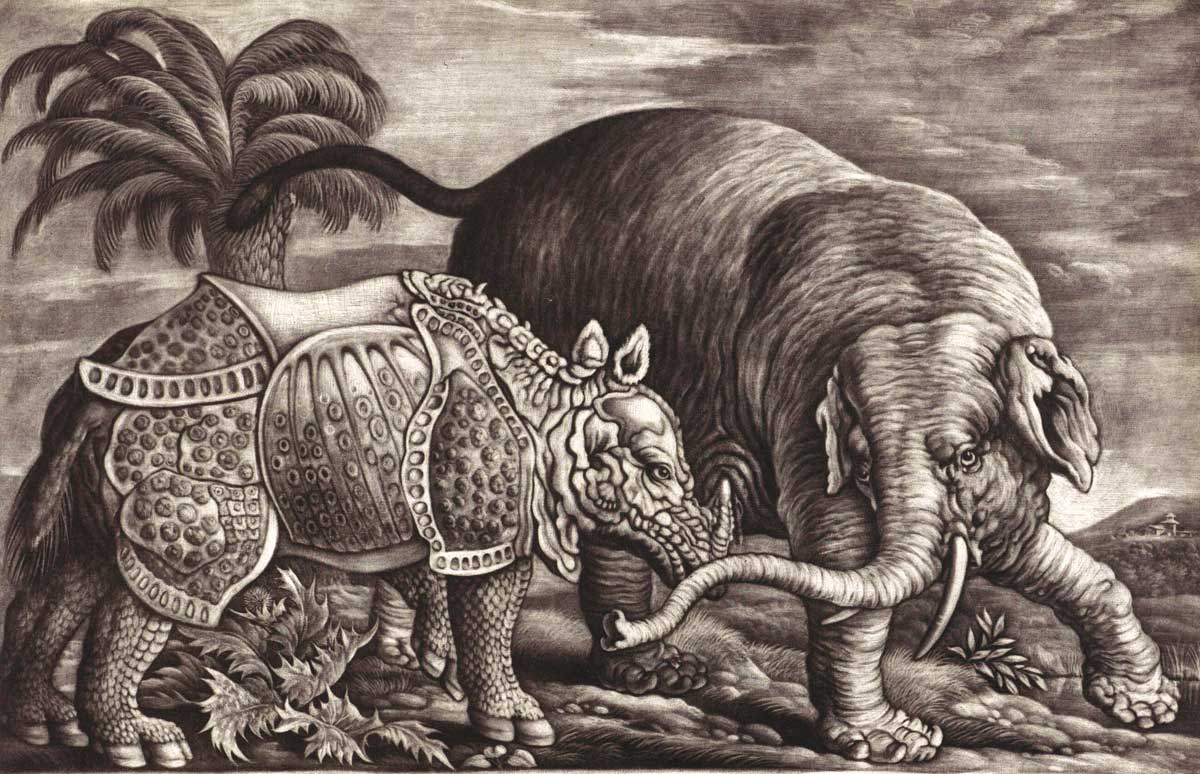Dürer’s Enduring Rhino | History Today - 10 minutes read

On 20 May 1515, the first Indian rhinoceros to set foot in Europe in more than 1,000 years arrived in Lisbon. A gift to Manuel I of Portugal from Alfonso de Albuquerque, who had himself received it from Sultan Muzafar I of Gujarat, it caused a sensation. News of the extraordinary beast spread like wildfire. Among those who took the lead was the Moravian printer, Valentim Fernandes. At some point in June, he sent a description, perhaps accompanied by a small sketch, to his humanist friends in Nuremberg. There, Fernandes’ letter (or another very like it), fell into the hands of Albrecht Dürer, who was so excited that he began working on a woodcut. Unfortunately, the result was quite staggeringly inaccurate. Though the accompanying text implied that it had been drawn ‘from life’, almost every aspect of it was wrong. With its heavy armour plating, its second horn halfway up the back, its three-toed feet and its cruel face, the poor animal looked more like a tank than the real thing.
Dürer was not the only artist to draw the rhinoceros. By the time his woodcut appeared, a number of other, more accurate, works were already in circulation. In Rome, in July 1515, Giovanni Giacomo Penni published a poetic description in ottava rima, with a crude, if jaunty, little picture on the title page. Further north, in Augsburg, Hans Burgkmair the Elder produced a more detailed print showing the rhino with spotted, leathery skin, a hairy neck, rounded horn and hangdog expression.
But it was Dürer’s woodcut which won out. Within a short space of time, it had eclipsed both Penni’s doodle and Burgkmair’s more accurate version – and would go on to shape how people viewed rhinoceroses for almost 300 years. Indeed, so total was its dominance that it was still the most recognisable picture of a pachyderm until well into the 20th century.
This is more than a little puzzling. At the time Dürer produced his woodcut he was one of the most pre-eminent artists of his day and had built his reputation on his rigorous – even obsessive – naturalism. He had written that, without the study of the natural world, there could be no art; and had produced dazzlingly realistic paintings of a Hare (1502) and a Great Piece of Turf (1503). So why did he content himself with such a patently inaccurate picture? And why did it prove so popular when much better representations were available?
Unnatural naturalism
At the heart of this problem is how Dürer and his contemporaries ‘saw’ the rhinoceros.
 Today, of course, we take it for granted that seeing is believing. When we observe an animal for ourselves, we adopt an objective stance and accept any evidence we gather about its appearance as true until we are proved wrong. But when Dürer’s rhinoceros arrived in Lisbon, things weren’t quite so straightforward. Europe was witnessing a revolution in how the animal kingdom was perceived. Whereas, in the past, the study of zoology had been guided by classical authorities, there was a growing sense that firsthand observation was also of vital importance. Soon enough, naturalists began collecting samples, taking notes and dissecting specimens, albeit in a rather haphazard way. This did not, however, mean that their observations were ‘objective’ (in the modern sense), or that they necessarily sought to challenge the authority of classical auctores. Quite the reverse. Though their methods may have been innovative, their investigations were still structured by classical assumptions – and the evidence they gathered was used principally to supplement or reaffirm the ‘truth’ of ancient knowledge.
Today, of course, we take it for granted that seeing is believing. When we observe an animal for ourselves, we adopt an objective stance and accept any evidence we gather about its appearance as true until we are proved wrong. But when Dürer’s rhinoceros arrived in Lisbon, things weren’t quite so straightforward. Europe was witnessing a revolution in how the animal kingdom was perceived. Whereas, in the past, the study of zoology had been guided by classical authorities, there was a growing sense that firsthand observation was also of vital importance. Soon enough, naturalists began collecting samples, taking notes and dissecting specimens, albeit in a rather haphazard way. This did not, however, mean that their observations were ‘objective’ (in the modern sense), or that they necessarily sought to challenge the authority of classical auctores. Quite the reverse. Though their methods may have been innovative, their investigations were still structured by classical assumptions – and the evidence they gathered was used principally to supplement or reaffirm the ‘truth’ of ancient knowledge.
When the rhinoceros arrived in Lisbon, the curiosity it provoked was conditioned by the same approach. Since most of those who clamoured to catch a glimpse had only come across such a beast in the works of classical authors such as Pliny the Elder, Aelian and Aristotle, they tended to view it through the lens of what they had read and found in it ‘confirmation’ of what they already knew. Despite the fact that it was apparently a rather placid creature, which had grown used to life in captivity long before it had left India, they were preoccupied with the idea that it was a ‘very fierce animal’ which fought elephants in the wild and went to great lengths to put its ‘ferocious’ character to the test. It was for this reason that, on taking delivery of his ‘pet’, Manuel I’s first reaction was to make it fight an elephant.
This tendency was even more pronounced among artists. Though the letters they received from correspondents like Fernandes had presumably arisen out of direct experience, the descriptions they offered had been distorted by classical influences – and were, in any case, incomplete. But since Penni, Burgkmair and Dürer had read the same ancient authorities, they saw no reason to question what they had been told – and even tried to fill in any gaps using their own knowledge of classical texts. To modern eyes this all seems absurdly misguided, not to mention inaccurate, but to them, the final effect would have seemed perfectly ‘naturalistic’.
Double-horned
Inevitably, there were some similarities between the three depictions. Since all three artists were familiar with Pliny’s account, they each took care to ensure that their rhinoceros had ‘the feet of an elephant and the tail of a boar’. But what set Dürer apart was how much further he pushed this. Despite his imperfect grasp of Latin, he appears to have teased out every last implication of Pliny’s description. If the rhinoceros was really as fierce as Pliny suggested, he reasoned, it must have had some sort of additional protection. Perhaps aware of Aelian’s remark that its hide was so tough it could be used in place of a plough, he therefore gave it rigid plates in place of a leathery skin, serrated hind quarters and a gorget similar to those he had seen in the armourers’ shops near where he lived. He didn’t stop there, though. Delving ever deeper into the recesses of classical literature, he found a host of other details which had been overlooked by Penni and Burgkmair. In Martial’s Epigrams he appears to have found a passage describing the rhinoceros as ‘double-horned’. Unaware that the author was talking about African, rather than Indian, rhinoceroses, he naturally assumed that he needed to add an extra horn; but since he could find no room on the end of the snout, he decided to place a small, spiral-shaped spike between the animal’s shoulders. Now known as the ‘Dürerhörnlein’ (‘Dürer’s little horn’), this looks pretty silly to us; but to Dürer, it would have seemed perfectly logical.

One of the reasons often given for the success of Dürer’s woodcut is his mastery of the printing process. Perhaps the first artist to derive the majority of his income from selling prints, Dürer had a talent for turning out bestsellers. Working closely with specialist cutters, he could produce large numbers of high quality prints in a short space of time. He then sold them through a network of agents across Europe and kept prices low so that anyone could afford them. According to one recent estimate, the Rhinoceros probably cost no more than the equivalent of a hamburger.
On its own, this does not explain the scale of the Rhinoceros’ triumph. After all, Burgkmair was hardly a novice at the printing trade, either. Though he may not have been as famous as Dürer, he was still the official printer to Emperor Maximilian I and had enjoyed great success with pioneering chiaroscuro prints such as Love Surprised by Death (1510). He was more than capable of producing bestsellers, as well.
Rather, what made Dürer’s so popular was what makes it so strange to us today. Since most people’s understanding of what a rhinoceros looked like came from classical descriptions, they would have regarded Dürer’s woodcut as more ‘naturalistic’ than Burgkmair’s or Penni’s and took this as proof that it had indeed been drawn ‘from life’, as he implied. Paradoxically, its unnaturalness made it appear natural and its novelty familiar.
A peculiar consequence of this was that, within a few years, the perceived authority of Dürer’s woodcut became self-reinforcing. Just as its fidelity to classical accounts had been used to verify Dürer’s claims to having taken it from life, so its ‘lifelike’ qualities were being used to validate classical descriptions, thus boosting its status even further. The clearest example is found in Conrad Gessner’s Historia animalium (1551-8). A huge, multi-volume work, this was intended to be the most comprehensive survey of animal life ever attempted and, like many other ‘scientific’ texts of its kind, gave pride of place to Dürer’s woodcut. Given how closely it corresponded to the major classical descriptions, Gessner saw no reason to doubt Dürer’s claim to have taken it ‘from life’ and used the ‘Dürerhörnlein’ to reconcile apparent ‘inconsistencies’ in the ancient sources.

Circular though this may have been, it served to establish Dürer’s Rhinoceros as the definitive statement of what a pachyderm should look like. By the 1530s, it had started to appear all over the place and in all kinds of media. In the 1570s, the weaver Nicholas Leynier included it in his ‘animal park’ tapestries for Kronborg Castle; a little later, Domenico Portigiani cast a version into the bronze doors of Pisa Cathedral; and scarcely a year went by without it being carved in stone or painted on porcelain. It was also invested with a host of allegorical meanings. Since it perfectly embodied Pliny’s description of it as a fierce and indefatigable beast, it was used to represent the virtues of strength and fortitude and to project an image of tireless determination. In 1536, for example, Alessandro de’ Medici adopted a slightly simplified version by Paolo Giovio as his emblem, together with the motto Non vulevo sin vencer (‘I shall not return without conquering’).
Dominance
As colonialism gathered pace, Indian rhinoceroses became more familiar to European audiences. Between 1579 and 1758, four further specimens are known to have been brought back from the subcontinent; and at least two (the so-called ‘Dutch’ and ‘first London’ rhinoceroses) were taken on tour. Coinciding with the development of a more rigorous scientific method, based solely on observation, these visits prompted a more searching enquiry into pachyderm physiology and the production of many more accurate representations (such as that by Philippe Gelle). But so indelibly had Dürer’s woodcut been imprinted upon European perceptions of rhinoceroses that it remained stubbornly popular. Even those who had actually seen a rhino often found themselves referring to it in descriptions and drawings. Thus, in Francis Barlow’s ‘True representation of … the Elephant and the Rhinoceros’ (c.1684-5), for example, the rhinoceros is plainly taken after Dürer’s. Though the second horn has been virtually omitted and the gorget replaced with thick folds of skin, it has a similarly sharp horn and the same armour-like plates covering its body. As late as the 1930s, it was still being used in German school textbooks; and even today, it remains a hauntingly familiar image – despite its obvious and undeniable inaccuracy.
It is a sobering reflection and perhaps may go some way to explaining why many countries still seem so reluctant to acknowledge the vulnerability of the species. More than 500 years since Dürer’s rhinoceros landed in Lisbon, as far as pachyderms are concerned, seeing is very far from believing.
Alexander Lee is a fellow in the Centre for the Study of the Renaissance at the University of Warwick. His latest book is Machiavelli: His Life and Times (Picador, 2020).
Source: History Today Feed